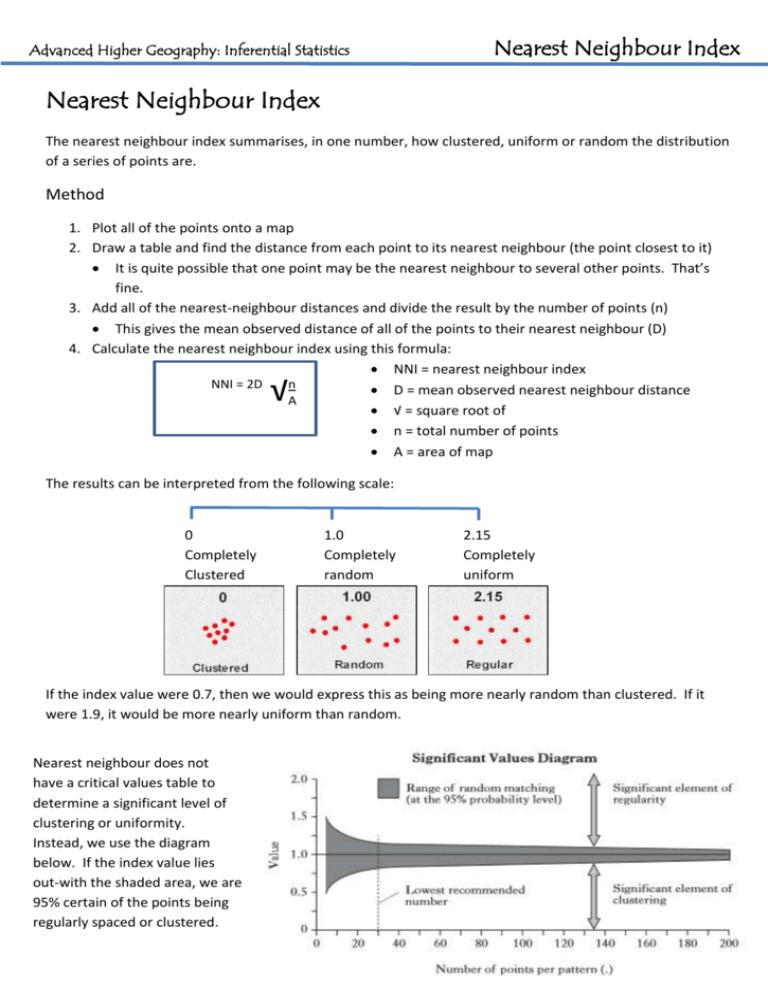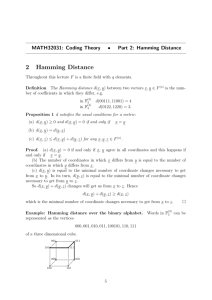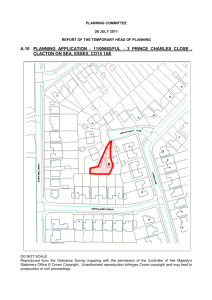worksheet
advertisement

Advanced Higher Geography: Inferential Statistics Nearest Neighbour Index Nearest Neighbour Index The nearest neighbour index summarises, in one number, how clustered, uniform or random the distribution of a series of points are. Method 1. Plot all of the points onto a map 2. Draw a table and find the distance from each point to its nearest neighbour (the point closest to it) It is quite possible that one point may be the nearest neighbour to several other points. That’s fine. 3. Add all of the nearest-neighbour distances and divide the result by the number of points (n) This gives the mean observed distance of all of the points to their nearest neighbour (D) 4. Calculate the nearest neighbour index using this formula: NNI = nearest neighbour index NNI = 2D n D = mean observed nearest neighbour distance A √ = square root of n = total number of points A = area of map √ The results can be interpreted from the following scale: 0 Completely Clustered 1.0 Completely random 2.15 Completely uniform If the index value were 0.7, then we would express this as being more nearly random than clustered. If it were 1.9, it would be more nearly uniform than random. Nearest neighbour does not have a critical values table to determine a significant level of clustering or uniformity. Instead, we use the diagram below. If the index value lies out-with the shaded area, we are 95% certain of the points being regularly spaced or clustered. Nearest Neighbour Index Advanced Higher Geography: Inferential Statistics Example ∑D = 24 n = 10 point 1 2 3 4 5 6 7 8 9 10 D = 24 = 2.4km 10 A = 256km2 NNI = 2D √ n A Nearest neighbour 2 1 2 5 6 5 8 7 10 9 Distance apart (km) 2.5 2.5 5 4 3 3 1 1 1 1 24 NNI = (2 x 2.4) x (√(10 x 256) = (2x2.4) x 0.2 = 0.96 (an almost random distribution) Possible Problems There are a number of problems with the nearest neighbour index: It cannot distinguish between a single and a multi-clustered pattern. Both the distributions in the picture below, although different, have a NNI of approximately o. Single and multi-clustered point patterns An index of 1.0 does not always mean that the distribution is totally random. Two sub-patterns on the map, when combined in one index, may give a false impression of randomness. The picture below has a NNI of approximately 1.0 although it is clearly not random. A distribution with an index of 1.0 should not be interpreted as being caused by random or chance factors. A pattern of settlements might have an NNI of 1.0, but every settlement is located at the site of a spring: the settlement cannot be said to be caused by chance.






